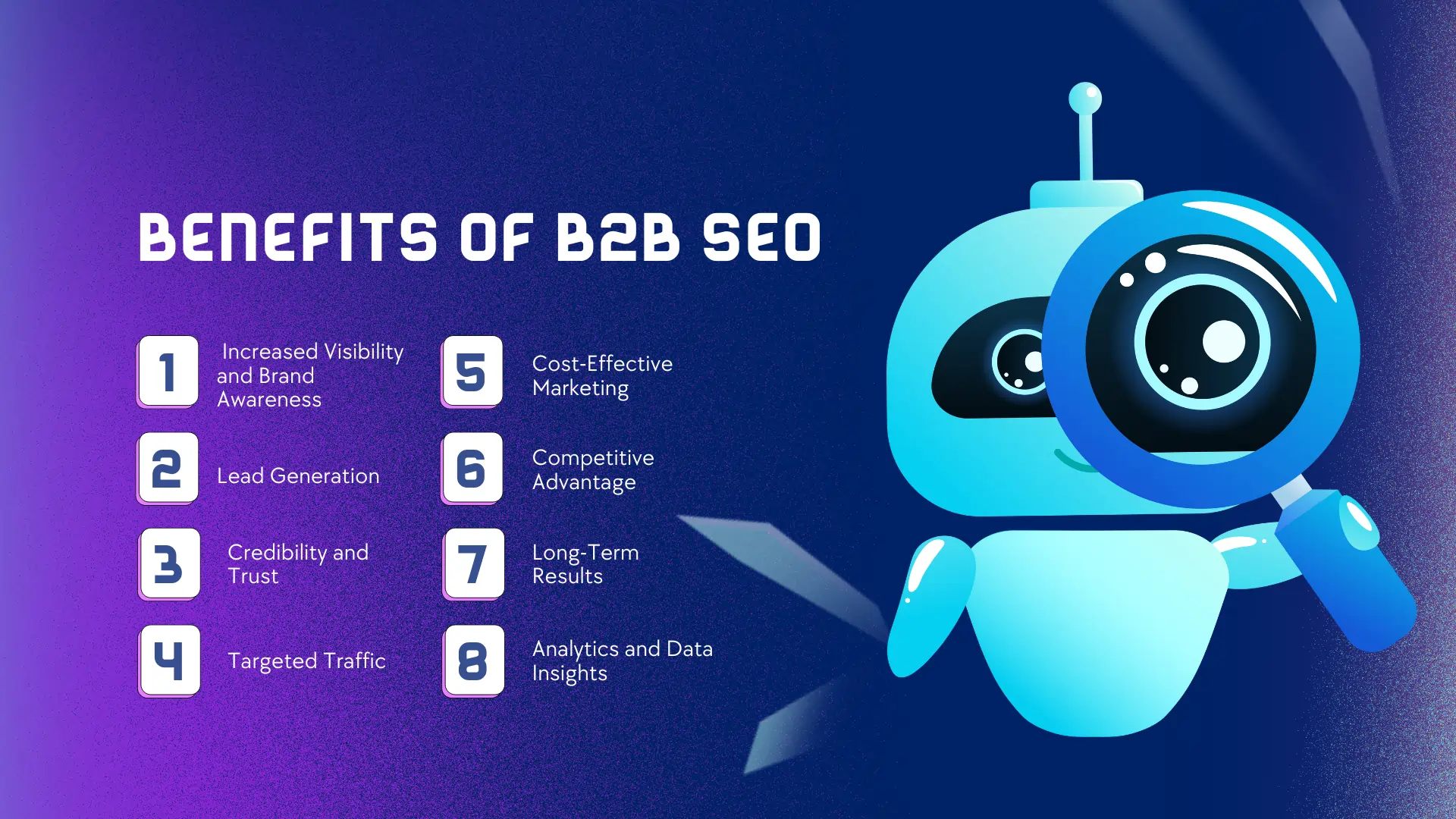Benefits of B2B SEO

Benefits of B2B SEO
Introduction:
B2B SEO, or Business-to-Business Search Engine Optimization, refers to the strategies and techniques employed to optimize the online presence of businesses that primarily target other businesses as their customers or clients. Unlike Business-to-Consumer (B2C) SEO, which focuses on reaching individual consumers, B2B SEO targets companies and professionals. The goal is to enhance visibility, generate quality leads, and ultimately drive business-to-business transactions.
Key Benefits of B2B SEO
B2B SEO (Business-to-Business Search Engine Optimization) offers several advantages for companies engaged in selling products or services to other businesses. Here are some key benefits:
1. Increased Visibility and Brand Awareness:
– B2B SEO enhances a company’s online visibility, ensuring that it appears in search results when potential business clients are actively searching for relevant products or services. This increased visibility contributes to brand awareness within the target B2B market.
2. Lead Generation:
– Effective B2B SEO strategies attract potential business clients who are actively searching for solutions. By optimizing for relevant keywords and creating valuable content, B2B companies can generate high-quality leads and inquiries from businesses interested in their offerings.
3. Credibility and Trust:
– High search engine rankings often convey credibility and trustworthiness. B2B SEO helps establish a company as an authority in its industry, instilling confidence in potential business partners and customers.
4. Targeted Traffic:
– B2B SEO allows companies to target specific keywords and phrases relevant to their industry and offerings. This precision helps attract highly targeted traffic, increasing the likelihood of engaging with businesses interested in the products or services offered.
5. Cost-Effective Marketing:
– Compared to traditional outbound marketing methods, B2B SEO can be a cost-effective strategy. Once a website is optimized and ranks well, it continues to attract organic traffic over time without incurring ongoing costs per click or impression.
6. Competitive Advantage:
– Companies investing in B2B SEO gain a competitive advantage by appearing prominently in search results. Outranking competitors in search engine listings can lead to increased market share and better positioning in the minds of potential B2B clients.
7. Long-Term Results:
– B2B SEO is a long-term strategy that, when implemented effectively, can provide sustainable results over time. Unlike some short-term marketing tactics, the benefits of SEO can compound and endure, delivering ongoing value.
8. Analytics and Data Insights:
– B2B SEO often involves tracking and analyzing performance metrics. Companies can gain valuable insights into user behavior, preferences, and market trends, enabling data-driven decision-making to further optimize their strategies.
9. Adaptation to Digital Trends:
– As more B2B transactions move online, having a strong online presence becomes increasingly important. B2B SEO allows companies to adapt to evolving digital trends and align their strategies with the way businesses research and make purchasing decisions.

A detailed 7-step B2B SEO strategy:
1. Comprehensive Keyword Research:
– Identify Industry-Specific Keywords:
• Understand the terminology and phrases used within the B2B industry.
• Utilize tools like Google Keyword Planner, SEMrush, or Ahrefs to find relevant keywords.
– Competitor Analysis:
• Analyse competitors in the B2B space to identify keywords they are targeting successfully.
• Look for gaps and opportunities in their strategies.
– Long-Tail Keywords:
• Focus on long-tail keywords that reflect specific queries and address the nuanced needs of B2B customers.
• Consider terms related to specific industries, solutions, and pain points.
2. Target Audience and Persona Development:
– Identify Decision-Makers:
• Clearly define the roles and titles of decision-makers within B2B organizations.
• Tailor content and SEO strategies to address the needs and challenges faced by these individuals.
– Create Buyer Personas:
• Develop detailed buyer personas representing different stakeholders involved in the B2B decision-making process.
• Understand their pain points, objectives, and information-seeking behaviors.
3. Content Marketing for Thought Leadership:
– Create In-Depth Industry-Specific Content:
• Develop blog posts, whitepapers, case studies, and webinars that showcase expertise in the B2B sector.
• Address industry trends, and challenges, and provide actionable insights.
– Gated Content for Lead Generation:
• Offer valuable resources behind forms to capture leads.
• Implement targeted landing pages for specific industries or solutions.
4. On-Page Optimization:
– Optimize Meta Titles and Descriptions:
• Include relevant B2B keywords in meta titles and descriptions.
• Craft compelling and informative snippets that encourage clicks.
– Header Tags and Structure:
• Use header tags (H1, H2, H3) to structure content logically.
• Include target keywords in headers to enhance SEO.
– Schema Markup for Rich Snippets:
• Implement Schema Markup to enhance rich snippets in search results.
• Highlight B2B-specific details like pricing, reviews, and product specifications.
5. Link Building and Networking:
– Build Relationships with Industry Publications:
• Outreach to industry publications for guest posting opportunities.
• Contribute high-quality content to authoritative platforms.
– Collaborate with Influencers and Thought Leaders:
• Establish relationships with B2B influencers and thought leaders.
• Collaborate on webinars, podcasts, or co-authored content.
– Acquire Quality Backlinks:
• Focus on obtaining backlinks from reputable B2B websites.
• Monitor and disavow low-quality or irrelevant links.
6. Technical SEO:
– Ensure Mobile Responsiveness:
• Optimize the website for mobile devices to cater to users accessing information on various devices.
• Prioritize a seamless user experience.
– Improve Page Speed:
• Optimize images, leverage browser caching, and use Content Delivery Networks (CDNs) to improve page loading times.
• A faster website contributes to better SEO performance.
– Fix Crawl Errors:
• Regularly check for crawl errors using tools like Google Search Console.
• Address issues such as broken links and crawl accessibility.
7. Analytics and Iterative Improvement:
– Set Key Performance Indicators (KPIs):
• Define B2B-specific KPIs such as lead generation, conversion rates, and organic traffic growth.
• Align KPIs with business objectives.
– Implement Advanced Analytics:
• Utilize Google Analytics and other analytics tools to track user behavior and conversion paths.
• Implement event tracking for specific B2B actions (e.g., form submissions).
– Iterative Improvement:
• Regularly review analytics data to identify areas for improvement.
• Adjust SEO strategies based on performance data, industry changes, and evolving B2B trends.

Conclusion
In conclusion, B2B SEO emerges as an indispensable strategy in the digital age, offering a nuanced set of advantages that extend beyond mere visibility and lead generation. This multifaceted approach not only establishes a brand’s credibility and trustworthiness but also strategically positions it against competitors, fostering long-term sustainability and adaptability to digital trends. B2B SEO’s cost-effectiveness, precision in targeting, and commitment to data-driven decision-making make it a cornerstone for companies navigating the intricate landscape of business-to-business interactions online, providing a resilient foundation for success in the dynamic world of digital marketing.
Partnered with Naumaan Oman
Search
Recent Posts
Working Together Ideas come to life
No matter how big your company is, as you expand and reach new highs you’ll want an agency to have your back. One with a process

© 2023 360PRESENCE All rights Reserved









